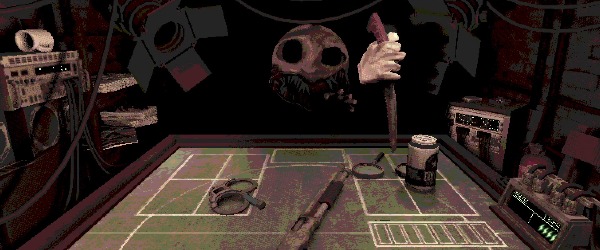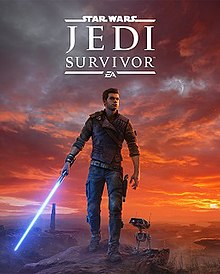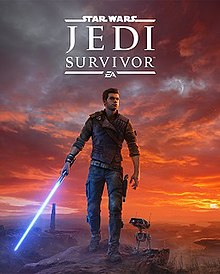
Star Wars Jedi: Survivor (PS5) - Review
by Miles Gregory , posted on 03 June 2023 / 4,067 ViewsLike many, I grew up on the Star Wars franchise. Sure, I’m not old enough to have watched the original trilogy in theaters, but I quite vividly remember seeing Episode 1: The Phantom Menace. Seeing Darth Maul with his double-sided lightsaber was the definition of “cool” for my five-year-old self, and prompted both me and my friend to take out our Icee straws and reenact the battle with Darth Maul, taking turns on who got to be Darth Maul and who got to be Obi-Wan and Qui-Gon.
This experience shaped my perception of the Star Wars universe quite significantly. Though I hold a fondness for the good versus evil overarching plots, as well as the huge variety of sub-plots, I’ve always been a bit preoccupied with over-the-top action sequences and force powers. Perhaps this's why I enjoy Episode 3: Revenge of the Sith so much. Regardless, there aren’t many games that have provided me with the appeal that I’ve been desperately craving. 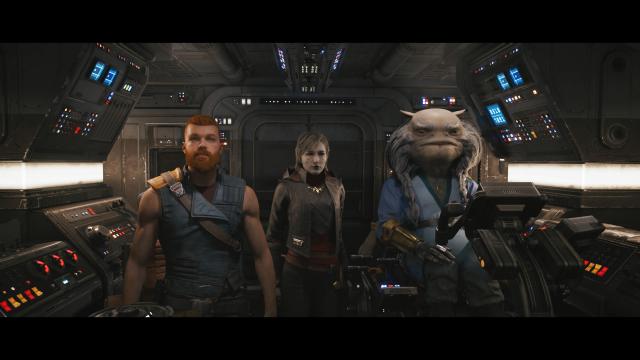
Star Wars Jedi: Survivor seeks to deliver exactly that type of action, expanding upon the foundation of its predecessor, Star Wars Jedi: Fallen Order, in almost every way. There are more areas to explore, more people to interact with, more powers and stances, and a longer campaign. The question is, does expanding upon everything in a game actually make it better? Many might say yes, but I’m not so sure.
Fallen Order incorporated some thoughtful level design with Metroidvania elements. That is, a gameplay style where certain areas in a level are locked until you discover the associated ability that allows you to traverse a specific obstacle. Survivor, of course, retains this same Metroidvania style, but appears much more open. I always felt that Fallen Order was akin to walking down a large hallway. Yes, there were plenty of branching pathways leading to different rooms, but you were constantly being funneled down a specific path. While some planets in Survivor, such as Coruscant, feel much in the same vein as its predecessor, other planets are more akin to gigantic colosseums with branching hallways instead of branching rooms, and feel more like actual planets. They're open, contain different biomes and structures, and you can legitimately get lost in them. This is especially true with the main hub area, Koboh. Upon initial landing you’ll notice rocky and dry terrain, but further exploration yields foggy marshes, huge structures of the empire, lively forests, and even mountains above the clouds. The variety found on this planet alone feels worthy of almost an entire game. Some planets even feature themed puzzles. For example, I really enjoyed the challenge found on Jedha early on, where you have to play “the floor is lava”, and find ways to traverse the planet without touching the sand for very long. 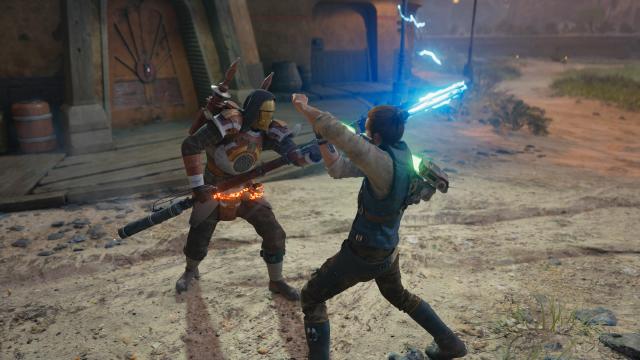
Survivor also provides frequent meditation areas and shortcuts, so backtracking is seldom a significant issue. If you find yourself having to walk for more than five minutes to get back to where you died, chances are you’ve missed a shortcut or a meditation point that could make the walk back much shorter. This also helps make exploring much less tedious than it can be in other Metroidvania-esque games. While pathways branch and the worlds are large, you can quite easily get back to a central area to recenter yourself. Meditation areas also act as Dark Souls-esque bonfires. These are where you'll wake up when you die, where you spend your skill points, and where you can choose to rest to heal and regenerate your stimpaks at the expense of respawning enemies.
What makes this so important is that there is a LOT of exploration to be had in this game. Respawn Entertainment, the developers of both Survivor and its predecessor, provided players with more of everything. There are challenges to find, quests to complete, bounties, treasure, items to increase your health and force meters, and even plants and fish to collect (yes, that’s right… fish). Rarely did I find myself spending more than a few minutes without finding a collectible of some kind.
Luckily, the implementation of all of these collectibles doesn’t feel like a burden or overstimulating. Generally, I found myself simply finding them naturally and not feeling it necessary to seek out every single collectible my first time through an area. This is due to the Metroidvania gameplay, where many areas simply cannot be completed until later in the game. The map that you're given also does a decent job in highlighting areas that haven’t been explored, or have been explored but have a secret that wasn't collected. That said, it can be quite annoying having to open up your map every few minutes when you're going back and grabbing those collectibles because there's no mini-map to quickly reference as you're exploring. Personally, I have a pretty good sense of direction, but with all the winding pathways even I had a difficult time without a brief piece of context to help guide me.
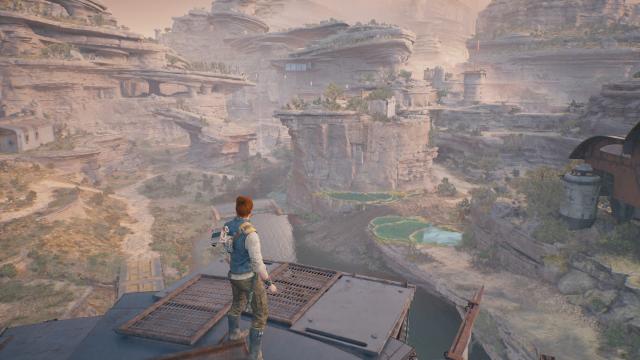
While the act of collecting these items isn’t annoying, I do question the reason for certain items as collectibles. Fish and trees, for example, don’t have any use besides being padding for trophy collecting. While I enjoy the banter between Skoova and the stories that he tells, I just don’t see the purpose behind obtaining the fish in order to stick them into an aquarium that you rarely ever see in-game. That said, I was more preoccupied with other collectibles, such as lightsaber customizations. Sure, these changes are really just for aesthetics, but there's something intrinsically funny about having Cal Kestis in army pants, a tank top, mullet, and mustache, carrying around a red, white, and blue lightsaber saving the galaxy in the name of America.
Other collectibles provide additional challenges which enhance the experience. Force tears are essentially challenge rooms that throw wave after wave of enemies at you. Sometimes these rooms limit the weapon that you're allowed to use, which forces you to get comfortable with a variety of stances if you strive to complete them. There's also a mini-game that can be played later on at the cantina. In order to unlock new combatants in the mini-game, BD-1 must scan defeated enemies. I appreciate the thought behind this. Though scanning enemies has some intrinsic value, I find it much more exciting to find a new enemy to defeat now that I know I can use it in my arsenal back at the cantina to unlock a new item or hairstyle if I win the mini-game.
Respawn took the time to not just expand upon Fallen Order's combat, but to make tweaks to make it feel more fluid overall. Cal Kestis feels like an experienced Jedi now, moving with the same grace we’ve seen from Yoda or Anakin from the prequels. He jumps, dashes, dodges, counters, and parries with a fluidity that most other Star Wars games haven’t been able to muster (outside of maybe Star Wars: The Force Unleashed). In addition, instead of only three different lightsaber options you now have five (dubbed “stances” in Survivor). The original three stances return (single-blade, dual-blade, and split-blade), along with a Kylo Ren-esque crossguard stance, and a single lightsaber coupled with a blaster stance. Each stance has accompanying statistics, such as speed, power, range, and defense.
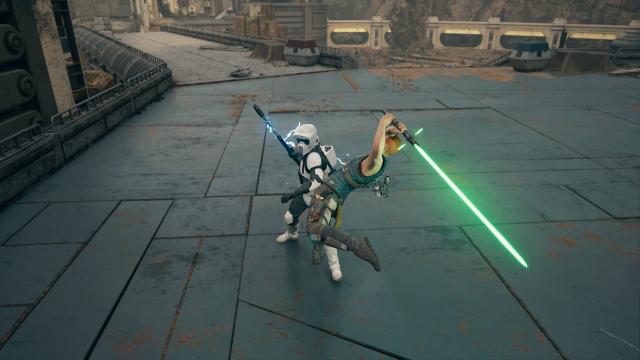
One issue that I had with the previous title is that combat didn’t feel impactful. Enemies felt a bit too much like sponges, where your lightsaber was just causing point damage and not actually having an effect on the enemy. That isn’t so in Survivor. Every hit feels more weighty and impactful. This is particularly true with the crossguard stance, which has an extremely slow wind-up that results in a very satisfying punch. Combat feels great when you get into a zone, where you're dodging and zipping across an area hitting enemy after enemy, lopping off droid arms and force pushing enemies off cliffs. It makes you feel like the Jedi you're supposed to be.
Unfortunately, enemies are just as impactful as you are. You'll frequently find yourself being assaulted by an onslaught of blasters while trying to attack an enemy that does nothing but block your attacks before retaliating with a move that cannot be blocked. Multiple large enemies have one-hit kills (or close to them), and blocking doesn’t always feel effective. This leads to some irritating moments. I lost count of the times that I died because I was hit by an unblockable move and, while trying to heal, was constantly berated by the enemy blasters, resulting in my eventual death because blocking the blasters meant getting attacked by a melee attack and dodging away meant getting hit by a blaster. Of course, this can sometimes be mitigated with the right playstyle, but sometimes it just felt cheap.
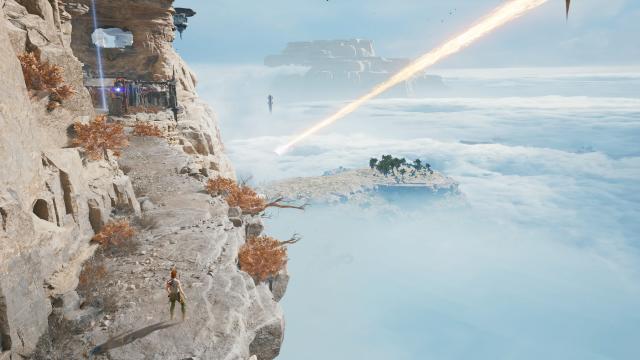
Bosses are numerous too, and, depending on the boss, can either be a highlight of the game's combat strengths or a magnification of its flaws. One area features several lightsaber-wielding bounty hunters and a Rancor. If you figure out how to use your surroundings appropriately, you can fight each bounty hunter individually. If you neglect to figure this out, you'll end up fighting all three together. Three against one was incredibly tough and required multiple attempts, but was entirely possible. Finding out that I could have faced each one individually was a treat, however. That said, the Rancor was nigh impossible. It didn’t appear to have any obvious weaknesses, had an incredibly fast one-hit kill move that could reach you from across the area, and even smaller attacks from the Rancor will break through your guard and still cause massive damage. While games like Dark Souls are frustrating, they still feel fair and possible. This enemy, however, felt like the only way to beat him was to cheese him, and even then it caused me a few deaths.
Lightsaber combat is only one part of the combat, however. There are a variety of force abilities at play here. Though there isn’t anything as intense as what's offered in The Force Unleashed, what has been introduced provides new ways to approach combat. You can use the force to have enemies fight on your behalf, you can force pull all enemies in a location towards you for a devastating area attack, you can lift and slam enemies down to the ground, and you can even use your force to automatically counter an enemy when in a tough position. BD-1 also has some more use here, providing electro darts to hack unsuspecting enemies from a distance in addition to slicing droids during combat. Some of these powers I used quite frequently to variable effect, but some were a bit too clumsy for me to feel like I could rely on them. When you pull off something that works, it feels satisfying though. Unfortunately, the combat isn’t forgiving enough to allow for much experimentation, so you're left relying on more tried and true methods of attacking.
The puzzles that are found in the game aren’t exactly brain teasers, but they can sometimes lead to fun “aha” moments, like the one above. Survivor is less puzzle-focused than the first title in general, though. The physics-based puzzles are, for the most part, gone, and the puzzle challenges that remain emphasize movement over mental acuity. Instead of thinking “how do I open this door”, you’ll be thinking “how do I get to the other side of this valley”. That said, the game's movement may, in fact, be one of its greatest strengths. One area had me solving a quick puzzle to raise a platform, then using that platform to wall run, grapple to a different platform, quickly double jump and dash over to another wall-running wall, dropping down to dash through a gate, dashing again to get enough distance to grab onto another grapple point, before finally getting across the chasm. I’m not sure if George Lucas intended for Jedis to be space ninjas at the time of conception, but that is absolutely what it feels like when accomplishing these challenges.
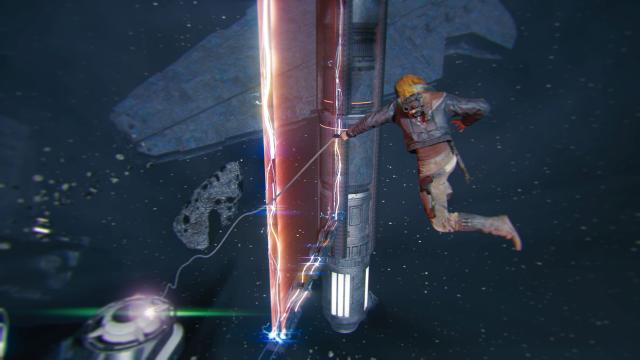
Cal also learns to use his force powers to interact with a variety of animals, which can then be ridden. These animals are used to traverse a variety of areas, from the desert wasteland of Jedha to the slippery slopes of Koboh. The animals aren’t specific to certain circumstances either, most of the time. One poor Nekko was sacrificed Yoshi style in order for me to get across a canyon that I’m not entirely sure I was supposed to cross at that point in the game. Nekkos in particular can be kept in stables too, allowing you to access and ride your Nekko easily and traverse great distances quickly. The use of animals as a mechanic is a smart way to unlock traversal skills without taking away from Cal’s arsenal that was built up in the previous game.
But, as is the theme with this entry, while the best moments feel great, the worst moments are almost hairpulling. The foundation for movement is fantastic, and feels very similar to Titanfall, another title by the developer Respawn. However, sometimes Cal will, for no reason at all, not grab onto a ledge or drop down from a ledge without warning. It's as if the developer coded only specific areas of a platform for clipping, and the rest act as areas that aren’t able to be climbed despite being part of the same platform. One cylindrical moving grate caused me to shut off the game for a breather because, right near the end, Cal would miraculously fall to his death. Each. And. Every. Time. Like the combat, I have no issue with difficulty, but when failure isn’t the fault of yourself but some invisible barrier, the game stops being fun. Luckily, this wasn’t a frequent occurrence, but it happened often enough for me to take note.
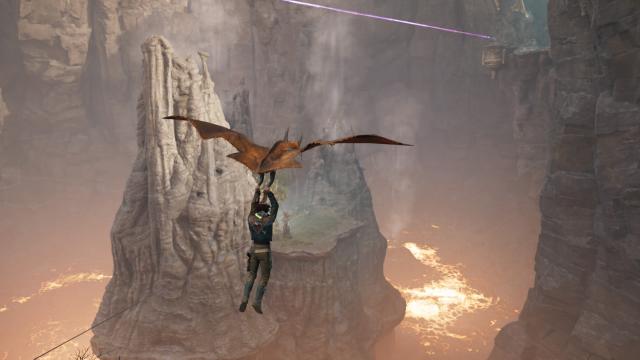
Where NPC interactions in Fallen Order were practically non-existent, here they're abundant. Of course, there are familiar faces that return which provide additional story sub-plots, comic relief, or even romantic interest, but there are also a large amount of random NPC interactions that are incorporated to flesh out the world. Some characters may give you rumors (Survivor's version of side-quests), whereas others may just provide you with context about the world around you. Regardless, having NPC interactions makes the world feel less desolate, even when you're on a mostly barren planet.
Survivor shares the same RPG mechanics as its antecedent. Enemies you face will provide you with experience points. Accumulation of enough will provide you with a skill point that can be spent at any meditation circle. Because of how many different stances and abilities there are, you’ll find yourself frequently leveling up to the next skill point to be spent. If you’ve put all your points into a stance that you no longer want to use, not a problem - you can easily reset your skill point allocation at any meditation circle. To complement alternative playstyles, there's also a perk system. These perks offer additional bonuses, such as better blocking, increased experience gained by defeating enemies, or even dealing extra damage when using certain stance moves (such as the blaster, or throwing your lightsaber). It’s a small addition, but one that could really help out specific playstyles.
Graphically, the game holds promise. Now, I say “promise” because of the extraordinary amounts of performance problems, glitches, and bugs that are featured in Survivor. I’ll start by focusing on the good: in still shots it's a sight to behold. Dense geometric meshes with high resolution textures truly impress. It also features ray-traced reflections and global illumination, creating a realistic feel while exploring the overworld of a planet. This, accompanied with the variety held within the planets themselves, creates astounding vignettes to capture in-game via the photo mode.
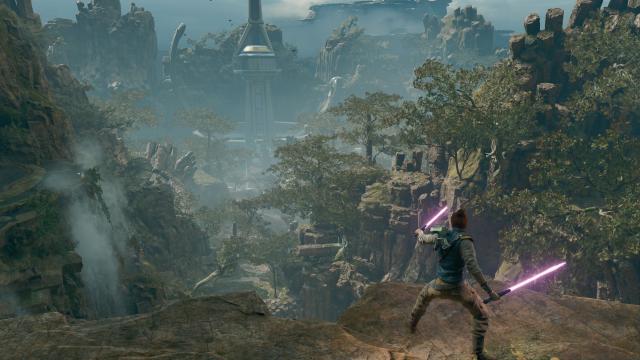
If Survivor was nothing but a bunch of still screenshots, I would be saying this is one of the better looking open-world games on current generation consoles. Games are meant to be played, though, and that’s when this one begins to break down. It features AMD FSR 2.1 on consoles to temporally upscale low resolutions to appear higher resolution. The internal rendering resolution is incredibly low, which causes artifacting and residual noise to be very apparent. This occurs quite often due to how fast the player character moves in-game.
Lighting and shadows are also inconsistent. Ray-traced global illumination is present, but shadows and ambient occlusion draw quite closely to the camera. In fact, pop-in in general is often an issue. It’s quite easy to see three or four different geometric LOD meshes appear or disappear as you approach an object. Reflections are ray-traced sometimes, but use SSR other times, with no apparent pattern to my eye. During times where ray-tracing could be used to the best effect it’s strangely absent. Of course, this could be a performance saving measure, but the already low resolution and poor performance all around makes me wonder what performance is even being saved here.
Performance in general is pretty unreasonable for a current-generation device. There are two modes - performance and quality - with little difference between them outside of the framerate cap, increased internal resolution, and maybe some improved shadows at a distance. Either mode you choose you’ll encounter unstable performance. General exploration during quality mode is mostly stable, but pretty much all action sequences cause dips, sometimes even to the low 20s.
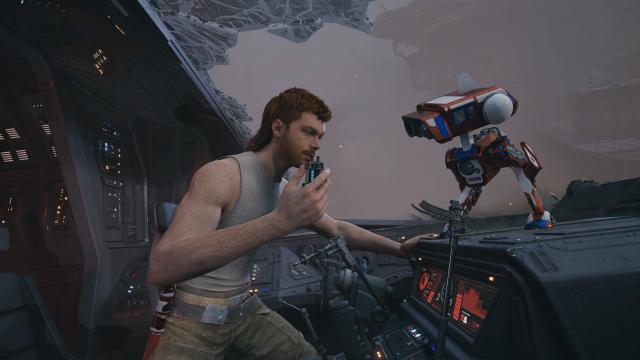
The performance mode suffers much more significantly. Though the framerate cap is set to 60 FPS, I don’t think there was a single time I actually hit that number. Instead, the framerate seems to hit the low 40s quite frequently, with even larger dips at times. To add insult to injury, performance mode suffers from significant and distracting screen tearing. Almost anytime that I turned the camera there was screen tearing present. This is somewhat rectified in the quality mode, though there are still points where it remains noticeable. Basically, I don’t see a good reason to enable performance mode here. The framerate isn’t stable enough for it to be a good experience, and the screen tearing causes more issues than it’s worth. Cut scenes look nice, but it’s obvious when these start because the framerate will chug for a few seconds before settling to something more stable, often lower than 30FPS.
Obviously this isn’t the only game to feature dips in framerate or screen tearing on next generation machines. However, the aggressive temporal upscaling solution, noticeable pop-in, half-rate effects (such as fire) and slow loading textures make me wonder what exactly is going on in this title that makes it so unstable. Perhaps ray-traced global illumination for a game this size is simply not optimized well enough in Unreal Engine 4, causing significant issues across the board. In which case, I think the developers should have allowed players to toggle ray-tracing on or off in order to boost performance to a more acceptable level.
I wish that were the end of the issues I experienced in Survivor, but it’s not. The game is filled with glitches galore. Some of them are mildly amusing, and others are terrifyingly problematic. I’ve experienced NPCs snapping into and out of different postures, finding them in a T-pose, weird texture glitches where parts of Cal’s skin becomes metallic (and even ray-traced), and teleporting enemies and NPCs. One soft-lock glitch early on almost had me repeat the first three hours of the game (though, luckily, a patch was provided the very next day, allowing me to continue my save). It's crashed on me once or twice, I’ve seen smoke effects completely disappear for no reason, and once BD-1 was stuck “ziplining” with a permanent grinding effect for the entirety of my playthrough until I turned my PS5 off, even during cut scenes.
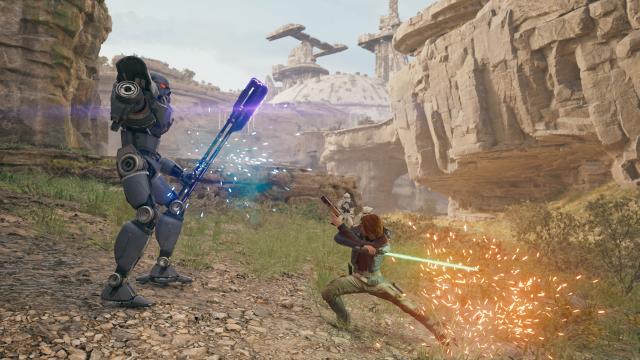
With all of this, I’m left conflicted. Star Wars Jedi: Survivor contains great core mechanics. Everything that developer Respawn has added improves upon Fallen Order in every measurable way. It’s just a shame that the delivery doesn’t do the foundation justice. To answer the question “does expanding upon everything in a game actually make it better?” - it can, but only if the developers have the ability to do so without causing significant technical hiccups. Unfortunately, that just didn’t happen with Survivor, and what we're left with is a title that has the potential to be great, but annoyingly misses its mark.
VGChartz Verdict
7
Good
This review is based on a retail copy of Star Wars Jedi: Survivor for the PS5











